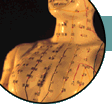Differentiating Syndromes of the Liver
Syndromes of liver blood insufficiency
Dizziness and vertigo, distending pain, redness of the eyes and face, anxiety and hot temper, dryness of the eyes, blurred vision, night blindness, numbness of the limbs, spasm of the tendons and muscles, scanty menstrual flow or amenorrhea, pale tongue proper, and thready pulse
Insufficiency of liver blood brings about malnutrition of the head and eyes, and manifests as dizziness, dryness of the eyes, and blurred vision. Consumption of liver blood causes malnourishment of the tendons, manifested by numbness of the limbs, and spasms of the tendons and muscles. The chong channel's "sea of blood" dries up due to an insufficiency of liver blood, so scanty menstrual flow or amenorrhea appears. Blood insufficiency also causes a pale tongue proper and a thready pulse.
Liver fire flare up syndromes
Dizziness, distending pain redness of the eyes and flushed face, irritability and irascibility, dryness and bitter taste in the mouth, deafness, ringing in the ears, burning pain of the costal and hypochondriac regions, yellowish urine, constipation or vomiting blood (hematemesis), and nose bleeds (epistaxis), red tongue proper with yellow coating, wiry and rapid pulse.
Liver fire flares up to attack the head and eyes causing dizziness, distending pain, redness of the eyes and flushed face, bitter taste and dryness in the mouth, deafness and ringing in the ears. Fire injures the liver causing a dysfunction of the qi flow and since the liver is related to emotional activities, depression and anger can result. As the liver channel passes through the costal and hypochondriac regions, it causes pain in these areas.
Liver fire exhausts the blood and injures the vessels, so hematemesis and epistaxis occur. Yellowish urine, constipation, yellow tongue coating, and a rapid pulse are also signs of excessive liver fire.
Liver qi stagnation syndromes
Fullness of the chest, mental depression, sighing, distending pain of the chest and hypochondrium, irascibility, anorexia, belching, abnormal bowel movements, irregular menstruation, dysmenorrhea, premenstrual distending pain of the breasts, thin and white tongue coating, and wiry pulse.
Stagnation of liver qi leads to the dysfunction of the liver causing an unrestrained flow of qi, so symptoms such as mental depression, fullness of the chest, irascibility, and sighing appear. Liver qi can also flow transversely to attack the stomach and spleen, causing disorders of the ascending and descending stomach and spleen qi. Symptoms of belching, anorexia, and abnormal bowel movements result. The liver stores blood, so liver qi stagnation will certainly affect menstruation causing irregularity, dysmenorrhea, or pre-menstrual distending pain of the breasts. A wiry pulse is also caused by liver qi stagnation.
Liver wind stirring syndromes
There are three conditions commonly seen in the clinic:
(1) Extreme heat stirring up endogenous wind, manifesting as high fever, convulsion, neck rigidity, contracture of the four limbs, opisthotonos, red tongue proper and a wiry rapid pulse.
(2) Yin deficiency leading to yang preponderance, this extreme yang then turns into wind and manifests as sudden temporary loss of consciousness (syncope), convulsion, deviated mouth and eyes, tongue rigidity, hemiplegia, wiry, slippery, and forceful pulse.
(3) Insufficiency of liver blood causes the malnutrition of tendons and muscles, and produces wind, manifesting as numbness of the limbs, tremor of muscles or spasms of the extremities, tremor of the hands, pal tongue proper, a wiry and thready pulse, etc.
The first condition is a group of shi syndromes caused by extreme heat producing wind, the wind and fire then stir each other. The second condition originates from a loss of liver and kidney yin which leads to liver yang preponderance and an upward flow of qi and blood. The root of this disease is therefore xu, but symptomatically the syndromes appear as shi type. The third condition is also a xu condition due to insufficiency of blood which leads to malnutrition of the tendons and muscles.
Stagnation of cold in the liver channel syndromes
Distending pain of the lower abdomen, swelling and distension of the testis with a bearing down pain, pain and contracture of the scrotum referring to the lower abdomen, a white slippery tongue, and a wiry slow pulse.
The liver channel curves around the external genitalia and passes through the lower abdominal region. Pathogenic cold is characterized by contraction and stagnation when it inhabits the liver channel. This results in the stagnation of qi and blood and causes the above symptoms.
Related Subjects
Read more on description of the main syndromes of other zang-fu organs:
Heart,
Spleen,
Lung,
Kidney,
Small Intestine,
Large Intestine,
Urinary Bladder,
Stomach, and
Gall Bladder.
|

 This website is published, edited and designed by Raymond Cheng,
and reflects only and only his personal views and opinions in his individual capacity.
The information available at this website is not intended
directly or by implication to either diagnose or treat any
medical, emotional, or psychological condition or disorder.
It is also not intended to create a physician-patient relationship
between you and I or between you and Wyith Institute™ and The Office of Dr Raymond K K Cheng.
The information here is not a substitute for advice and treatment provided
by your physician or by another healthcare professional.
It is always recommended that consultation with local healthcare providers
be obtained for any of your specific health or medical concerns.
Furthermore, any products that can be purchased (yet you can see I don't have much
to sell here) through advertisers' banners or through links to other websites
are not either explicitly or implicitly given any warranty or endorsement
by me, my colleagues, Wyith Institute™ or any of its associated businesses.
This website is published, edited and designed by Raymond Cheng,
and reflects only and only his personal views and opinions in his individual capacity.
The information available at this website is not intended
directly or by implication to either diagnose or treat any
medical, emotional, or psychological condition or disorder.
It is also not intended to create a physician-patient relationship
between you and I or between you and Wyith Institute™ and The Office of Dr Raymond K K Cheng.
The information here is not a substitute for advice and treatment provided
by your physician or by another healthcare professional.
It is always recommended that consultation with local healthcare providers
be obtained for any of your specific health or medical concerns.
Furthermore, any products that can be purchased (yet you can see I don't have much
to sell here) through advertisers' banners or through links to other websites
are not either explicitly or implicitly given any warranty or endorsement
by me, my colleagues, Wyith Institute™ or any of its associated businesses.



 Thank you for visiting this TCM and acupuncture information website.
If you have previously been to this website, you might have
noticed that some of the pages on ancient historical ideas and
holistic thinkings related to Chinese metaphysics are temporarily taken offline.
This is because I will be revamping the whole website and be moving
those information into a new \"Ancient Chinese Culture\" section
so as to reflect a more current perspective on the interpretation
of some of the fundamental concepts as well as to include
some of the latest information in the area.
But if you have just found this website for the very first time, I welcome you again and
wish you could find what you require and, hopefully, you could also be benefitted
from reading the articles I published on this website.
Thank you for visiting this TCM and acupuncture information website.
If you have previously been to this website, you might have
noticed that some of the pages on ancient historical ideas and
holistic thinkings related to Chinese metaphysics are temporarily taken offline.
This is because I will be revamping the whole website and be moving
those information into a new \"Ancient Chinese Culture\" section
so as to reflect a more current perspective on the interpretation
of some of the fundamental concepts as well as to include
some of the latest information in the area.
But if you have just found this website for the very first time, I welcome you again and
wish you could find what you require and, hopefully, you could also be benefitted
from reading the articles I published on this website.